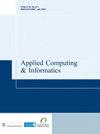Precise and parallel segmentation model (PPSM) via MCET using hybrid distributions
IF 4.9
Q1 COMPUTER SCIENCE, INFORMATION SYSTEMS
引用次数: 6
Abstract
PurposeImage segmentation is one of the most essential tasks in image processing applications. It is a valuable tool in many oriented applications such as health-care systems, pattern recognition, traffic control, surveillance systems, etc. However, an accurate segmentation is a critical task since finding a correct model that fits a different type of image processing application is a persistent problem. This paper develops a novel segmentation model that aims to be a unified model using any kind of image processing application. The proposed precise and parallel segmentation model (PPSM) combines the three benchmark distribution thresholding techniques to estimate an optimum threshold value that leads to optimum extraction of the segmented region: Gaussian, lognormal and gamma distributions. Moreover, a parallel boosting algorithm is proposed to improve the performance of the developed segmentation algorithm and minimize its computational cost. To evaluate the effectiveness of the proposed PPSM, different benchmark data sets for image segmentation are used such as Planet Hunters 2 (PH2), the International Skin Imaging Collaboration (ISIC), Microsoft Research in Cambridge (MSRC), the Berkley Segmentation Benchmark Data set (BSDS) and Common Objects in COntext (COCO). The obtained results indicate the efficacy of the proposed model in achieving high accuracy with significant processing time reduction compared to other segmentation models and using different types and fields of benchmarking data sets.Design/methodology/approachThe proposed PPSM combines the three benchmark distribution thresholding techniques to estimate an optimum threshold value that leads to optimum extraction of the segmented region: Gaussian, lognormal and gamma distributions.FindingsOn the basis of the achieved results, it can be observed that the proposed PPSM–minimum cross-entropy thresholding (PPSM–MCET)-based segmentation model is a robust, accurate and highly consistent method with high-performance ability.Originality/valueA novel hybrid segmentation model is constructed exploiting a combination of Gaussian, gamma and lognormal distributions using MCET. Moreover, and to provide an accurate and high-performance thresholding with minimum computational cost, the proposed PPSM uses a parallel processing method to minimize the computational effort in MCET computing. The proposed model might be used as a valuable tool in many oriented applications such as health-care systems, pattern recognition, traffic control, surveillance systems, etc.基于混合分布的精确并行分割模型(PPSM)
目的图像分割是图像处理应用中最重要的任务之一。它是许多面向应用的宝贵工具,如医疗保健系统、模式识别、交通控制、监控系统等。然而,准确的分割是一项关键任务,因为找到适合不同类型图像处理应用的正确模型是一个持久的问题。本文开发了一种新的分割模型,旨在成为使用任何类型的图像处理应用程序的统一模型。所提出的精确并行分割模型(PPSM)结合了三种基准分布阈值技术来估计最佳阈值,从而优化分割区域的提取:高斯分布、对数正态分布和伽玛分布。此外,还提出了一种并行boosting算法,以提高所开发的分割算法的性能并最小化其计算成本。为了评估所提出的PPSM的有效性,使用了用于图像分割的不同基准数据集,如Planet Hunters 2(PH2)、国际皮肤成像协作组织(ISIC)、剑桥微软研究中心(MSRC)、伯克利分割基准数据集(BSDS)和上下文中的公共对象(COCO)。所获得的结果表明,与其他分割模型相比,所提出的模型在实现高精度的同时显著减少了处理时间,并且使用了不同类型和领域的基准数据集。设计/方法/方法所提出的PPSM结合了三种基准分布阈值技术,以估计最佳阈值,从而优化分割区域的提取:高斯分布、对数正态分布和伽马分布。发现在所获得的结果的基础上,可以观察到所提出的基于PPSM-最小交叉熵阈值(PPSM–MCET)的分割模型是一种稳健、准确、高度一致的方法,具有高性能。独创性/价值利用MCET结合高斯、伽玛和对数正态分布构建了一个新的混合分割模型。此外,为了以最小的计算成本提供准确和高性能的阈值,所提出的PPSM使用并行处理方法来最小化MCET计算中的计算工作量。所提出的模型可能被用作许多面向应用的宝贵工具,如医疗保健系统、模式识别、交通控制、监控系统等。
本文章由计算机程序翻译,如有差异,请以英文原文为准。
求助全文
约1分钟内获得全文
求助全文
来源期刊

Applied Computing and Informatics
Computer Science-Information Systems
CiteScore
12.20
自引率
0.00%
发文量
0
审稿时长
39 weeks
期刊介绍:
Applied Computing and Informatics aims to be timely in disseminating leading-edge knowledge to researchers, practitioners and academics whose interest is in the latest developments in applied computing and information systems concepts, strategies, practices, tools and technologies. In particular, the journal encourages research studies that have significant contributions to make to the continuous development and improvement of IT practices in the Kingdom of Saudi Arabia and other countries. By doing so, the journal attempts to bridge the gap between the academic and industrial community, and therefore, welcomes theoretically grounded, methodologically sound research studies that address various IT-related problems and innovations of an applied nature. The journal will serve as a forum for practitioners, researchers, managers and IT policy makers to share their knowledge and experience in the design, development, implementation, management and evaluation of various IT applications. Contributions may deal with, but are not limited to: • Internet and E-Commerce Architecture, Infrastructure, Models, Deployment Strategies and Methodologies. • E-Business and E-Government Adoption. • Mobile Commerce and their Applications. • Applied Telecommunication Networks. • Software Engineering Approaches, Methodologies, Techniques, and Tools. • Applied Data Mining and Warehousing. • Information Strategic Planning and Recourse Management. • Applied Wireless Computing. • Enterprise Resource Planning Systems. • IT Education. • Societal, Cultural, and Ethical Issues of IT. • Policy, Legal and Global Issues of IT. • Enterprise Database Technology.
 求助内容:
求助内容: 应助结果提醒方式:
应助结果提醒方式:


